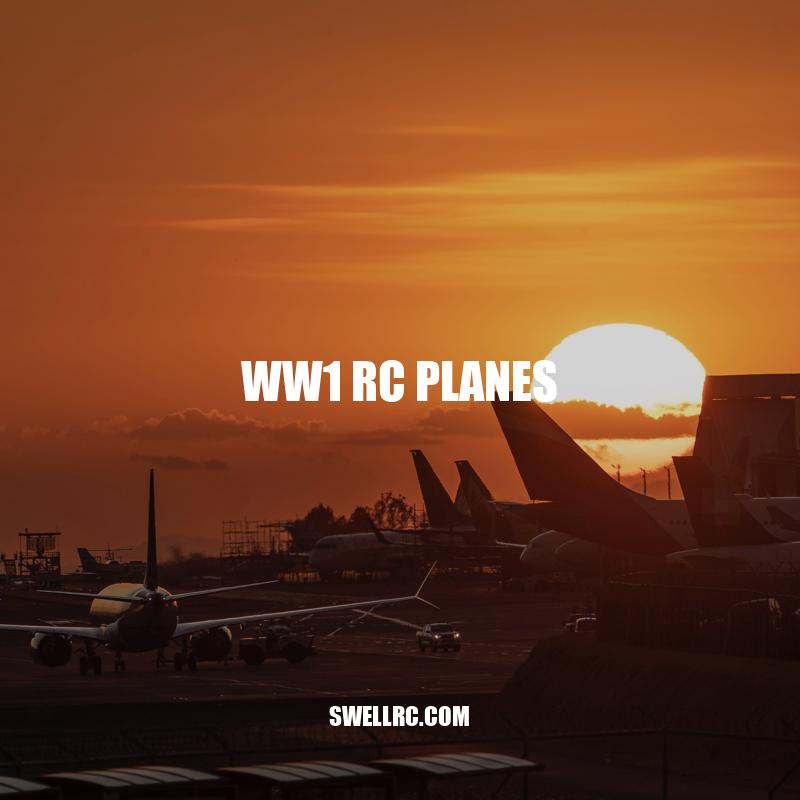WW1 RC Planes: A Thrilling Experience for Aviation Enthusiasts
World War 1 was a war that saw unprecedented industrial innovation and technological advancements in weaponry and defense. One of the areas that saw significant innovation was the aviation industry, where the need for air superiority prompted nations to invest heavily in aircraft technology. WW1 planes played a crucial role in reconnaissance, aerial combat, and bombing missions. The planes used in WW1 were the precursors to modern fighter planes, and while technology has evolved significantly since then, aviation enthusiasts still hold a particular fascination for these warbirds. With the advent of remote control (RC) planes, enthusiasts can now acquire WW1 RC planes, which are meticulously built replicas of the planes used in WW1. These planes are designed to mimic the original planes’ unique features and fly in a way that captures the essence of the air battles of the era, giving aviation enthusiasts an opportunity to experience these WW1 planes’ thrill.
Design and Features of WW1 RC Planes
WW1 RC planes feature intricate designs and intricate details that mimic the original planes. Here are some of the features of these planes:
- Bi-wing design with extended wingspan
- Wire-braced wings that are lighter and more flexible
- A single propeller to provide thrust
- Fabric covering the lightweight frame to resemble the original planes
- Low speeds of around 20 to 40 miles per hour to mimic the original planes’ movement in the air
- Radio control system that utilizes throttle, rudder, and elevators to control movement through the air
- Various sizes ranging from a mini RC plane of about 20 inches to a large RC plane of around six feet
These features are a hallmark of WW1 planes. Their accurate replication adds to their appeal to aviation enthusiasts who want a thrilling experience of flying a warbird without actually feeling the dangers and risks of flying in a real WW1 plane. Many dedicated websites offer information on building, customizing, and flying WW1 RC planes for enthusiasts who want to join the trend. Some of the available planes are DIY versions that require expertise in building and customization or can be purchased ready to fly, complete with engines, radio transmitters, and control systems. The planes can also be customized, with enthusiasts adding on their products such as smoke machines for added visual effect during flight.
If you are interested in purchasing a WW1 RC plane, you can choose from different brands with a variety of options and features that you may want to explore.
What are the features of a plane?
The key features of a plane are its wing system, tail surfaces, movable surfaces, and power plant. These components work together to keep the plane flying steadily and move it forward through the air. For more detailed information about planes, you can visit aviation websites such as aviationweek.com or products such as Microsoft Flight Simulator.
Building and Flying WW1 RC Planes
Building and flying WW1 RC planes is an exciting and challenging experience. Here are some steps to follow when building and flying an RC WW1 plane:
- Step 1: Choose the type of WW1 plane that you want to replicate
- Step 2: Gather the building materials such as balsa wood, covering fabric, and engine
- Step 3: Build the frame of the RC plane
- Step 4: Cover the frame with fabric until it is tight and smooth
- Step 5: Install the engine and control surfaces such as the rudder and elevators
- Step 6: Test the movements and controls of the plane before flight
- Step 7: Ensure that the radio transmitter is working efficiently
- Step 8: Practice on a simulator before attempting actual flying
Once you have built the WW1 RC plane, the next step is learning how to fly it. Here are a few tips:
- Keep the plane in sight at all times
- Choose a large space with few or no obstacles for the first few flights
- Start the takeoff by running with the plane until it gains enough speed, then let go
- Move the control sticks gently and avoid jerky movements that may destabilize the plane
- Landing is the most challenging part of flying an RC plane. Try to reduce the speed by lowering the throttle, tilting the plane’s nose upwards, and gradually lowering it onto the ground.
It’s advised to start with a simulator before attempting actual flight to reduce the risk of damaging the plane and give beginners time to practice. WW1 RC planes also require regular maintenance to ensure that they remain in excellent condition. There are various online forums, such as rcgroups.com, dedicated to WW1 RC planes, where enthusiasts exchange ideas, share tips and showcase their models. Rcgroups.com includes a wealth of information, purchase options, and aviation games. The below table comprises popular WW1 RC plane models and their specifications:
| Model | Dimensions (in) | Wingspan (in) | Weight (lb) |
|---|---|---|---|
| Fokker DR.1 | 36.5 x 29.5 x 13.25 | 24 | 6.7 |
| Sopwith Camel | 31.5 x 22.5 x 3.8 | 28 | 4.41 |
| Curtiss Jenny | 40 x 58.5 x 16.5 | 56 | 16 |
Keywords: WW1 planes, WW1 RC planes, building RC planes, flying RC planes, building materials, radio transmitter, online forums, simulator.
How do you fly an RC plane for the first time?
Flying an RC plane for the first time can be an exciting but nerve-wracking experience. Here are some tips to get started:
1. Choose the right location: Look for an open and spacious area with minimal obstructions and people around. Avoid crowded parks or public places.
2. Familiarize yourself with the controls: Read the instructions manual carefully and get a good understanding of the controls such as throttle, rudder, elevator, and ailerons.
3. Practice on a simulator: Practice flying an RC plane on a simulator before attempting to fly an actual plane. This can help you get used to the controls and develop better reflexes.
4. Start with a trainer plane: Choose a beginner-friendly trainer plane with a stable flight performance. These planes are designed to be forgiving and easy to fly.
5. Take it slow: Start with gentle and slow movements, and focus on keeping the plane level and steady.
Remember that it takes time and practice to become a skilled RC plane pilot. Don’t get discouraged if you crash your plane a few times. Just keep practicing and improving your skills.
If you’re looking for more information or want to buy an RC plane, there are many websites and products available online. One such website is HorizonHobby.com, which offers a wide range of RC planes, simulators, and accessories for beginners and experienced pilots alike.
Conclusion
WW1 RC planes are excellent options for aviation enthusiasts who want to experience the thrill of flying a vintage warplane. Building and flying these planes requires a level of skill and patience. RC WW1 planes are not as stable as modern RC planes and require more attention and finesse to control in the air. It’s essential to invest time in learning how to fly the plane before attempting to fly the actual plane.
To enhance the experience of flying WW1 RC planes, enthusiasts can invest in add-ons such as sound generators and smoke machines to enhance realism during simulation. There are also several online resources such as forums and websites dedicated to providing information about WW1 RC planes. These communities bring together aviation enthusiasts to share information, tips, and showcase their WW1 RC plane models.
WW1 RC planes allow individuals to delve into history, explore the evolution of aviation technology and enjoy the adrenaline that comes with flying. Building and flying WW1 RC planes can be challenging and rewarding, but the end result is always exhilarating. Anyone with the desire to build and fly these planes can do so with the proper knowledge, equipment and, most importantly, patience.
Keywords: WW1 planes, WW1 RC planes, aviation enthusiasts, add-ons, online resources, history, aviation technology.



